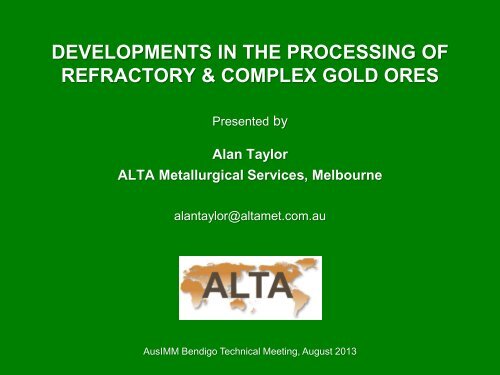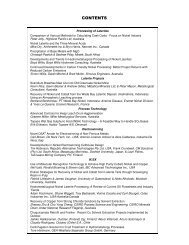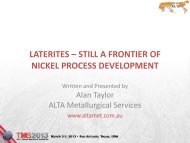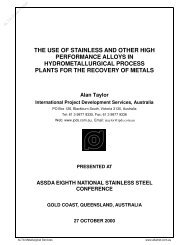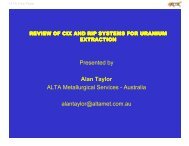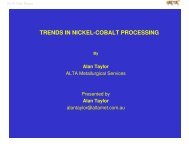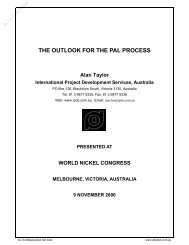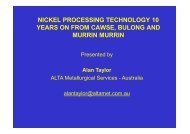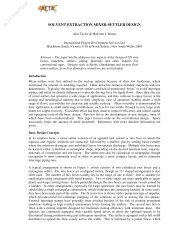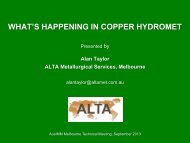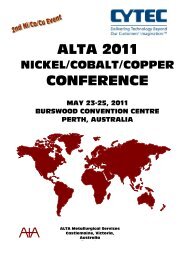developments in the processing of refractory & complex gold ores
developments in the processing of refractory & complex gold ores
developments in the processing of refractory & complex gold ores
You also want an ePaper? Increase the reach of your titles
YUMPU automatically turns print PDFs into web optimized ePapers that Google loves.
DEVELOPMENTS IN THE PROCESSING OF<br />
REFRACTORY & COMPLEX GOLD ORES<br />
Presented by<br />
Alan Taylor<br />
ALTA Metallurgical Services, Melbourne<br />
alantaylor@altamet.com.au<br />
AusIMM Bendigo Technical Meet<strong>in</strong>g, August 2013
INTRODUCTION<br />
The <strong>in</strong>creas<strong>in</strong>g trend towards lower grade and more <strong>complex</strong> <strong>ores</strong><br />
and <strong>the</strong> need for lower cost processes especially for small deposits<br />
have resulted <strong>in</strong> <strong>the</strong> <strong>in</strong>troduction <strong>of</strong> a variety <strong>of</strong> new processes<br />
which are at various stages <strong>of</strong> development.<br />
Additional <strong>in</strong>centives <strong>in</strong>clude <strong>in</strong>creas<strong>in</strong>g environmental pressure<br />
aga<strong>in</strong>st <strong>the</strong> use <strong>of</strong> cyanide, concern over <strong>the</strong> release <strong>of</strong> toxic<br />
elements and <strong>the</strong> need to conserve water resources.<br />
2
• Ores conta<strong>in</strong><strong>in</strong>g <strong>gold</strong> locked <strong>in</strong> solid solution or as f<strong>in</strong>e<br />
<strong>in</strong>clusions <strong>in</strong>clude:<br />
- iron/arsenic sulphide m<strong>in</strong>erals such as arsenopyrite, arsenian<br />
pyrite, and pyrite<br />
- copper sulphides such as chalcopyrite, tetrahedrite<br />
- none sulphide gangue m<strong>in</strong>erals such as silica m<strong>in</strong>erals, iron<br />
oxides<br />
• Ores with <strong>in</strong>soluble or slow leach<strong>in</strong>g <strong>gold</strong> m<strong>in</strong>erals <strong>in</strong>clud<strong>in</strong>g:<br />
– <strong>gold</strong> tellurides<br />
– aurostibnite – AuSb 2<br />
– Maldonite – Au 2 Bi<br />
ORE CATEGORIES<br />
– Fischesserite - Ag 3 AuSe 2<br />
• Ores conta<strong>in</strong><strong>in</strong>g preg-robb<strong>in</strong>g constituents such carbonaceous<br />
material or clays.<br />
3
ORE CATEGORIES (CONT.)<br />
• Ores conta<strong>in</strong><strong>in</strong>g cyanide and/or oxygen consumers <strong>in</strong>clud<strong>in</strong>g:<br />
- oxide/hydroxide copper m<strong>in</strong>erals, native copper, secondary<br />
copper sulphide m<strong>in</strong>erals<br />
- reactive iron sulphide m<strong>in</strong>erals, pyrrhotite, marcasite<br />
- reactive antimony and arsenic sulphide m<strong>in</strong>erals,<br />
stibnite Sb 2 S 3 , orpiment As 2 S 3 , realgar As 4 S 4<br />
Note:<br />
More than one category can apply to a particular ore deposit;<br />
e.g. double <strong>refractory</strong> <strong>ores</strong> <strong>in</strong> Nevada with <strong>gold</strong> locked <strong>in</strong> iron<br />
sulphides plus preg-robb<strong>in</strong>g carbonaceous material.<br />
4
Note: covellite solubility is similar to chalcocite.<br />
(Ref: “Cyanamid wants you to know”, May 1955)<br />
5
TREATMENT PROCESSES<br />
6
LOCKED GOLD<br />
Iron/Arsenic Sulphides - pretreatment processes <strong>in</strong>clude:<br />
• Roast<strong>in</strong>g <strong>of</strong> whole ore or flotation concentrate.<br />
• Low pressure <strong>in</strong>tensive oxidation.<br />
• Acid or alkal<strong>in</strong>e pressure oxidation <strong>of</strong> whole ore or flotation<br />
concentrate.<br />
• Bio-oxidation <strong>of</strong> flotation concentrate.<br />
• F<strong>in</strong>e or ultraf<strong>in</strong>e gr<strong>in</strong>d<strong>in</strong>g <strong>of</strong> flotation concentrate followed by<br />
direct cyanidation or one <strong>of</strong> <strong>the</strong> above pretreatment processes.<br />
• Heap bio-oxidation <strong>of</strong> whole ore or flotation concentrate.<br />
Copper Sulphides – flotation followed by smelt<strong>in</strong>g, roast<strong>in</strong>g or<br />
hydromet treatment <strong>of</strong> concentrate.<br />
Non-Sulphide Gangue M<strong>in</strong>erals – f<strong>in</strong>e gr<strong>in</strong>d<strong>in</strong>g <strong>of</strong> whole ore<br />
followed by direct cyanidation.<br />
7
INSOLUBLE OR SLOW LEACHING GOLD MINERALS<br />
• Roast<strong>in</strong>g <strong>of</strong> flotation concentrate followed by cyanidation.<br />
• Alkal<strong>in</strong>e chlor<strong>in</strong>ation leach<strong>in</strong>g <strong>of</strong> flotation concentrate followed<br />
by cyanidation.<br />
• Low pressure cyanidation <strong>of</strong> flotation concentrate.<br />
8
Oxidised or Low Sulphide Ores<br />
PREG-ROBBING ORES<br />
• Maximization <strong>of</strong> <strong>gold</strong> recovery by gravity plus <strong>in</strong>tensive<br />
cyanidation <strong>of</strong> concentrate.<br />
• Application <strong>of</strong> CIL with high carbon concentration.<br />
• Addition <strong>of</strong> kerosene or o<strong>the</strong>r substance to blanket <strong>the</strong> pregrobb<strong>in</strong>g<br />
material followed by CIL or RIL (not subject to foul<strong>in</strong>g).<br />
• Chlor<strong>in</strong>ation to deactivate <strong>the</strong> carbonaceous material.<br />
• Roast<strong>in</strong>g to burn <strong>of</strong>f <strong>the</strong> carbonaceous material.<br />
Ores with Gold Locked <strong>in</strong> Sulphides<br />
• Roast<strong>in</strong>g <strong>of</strong> whole ore or flotation concentrate to burn <strong>of</strong>f <strong>the</strong><br />
carbonaceous material and oxidize <strong>the</strong> <strong>gold</strong> bear<strong>in</strong>g sulphide .<br />
• Pressure oxidation to deactivate <strong>the</strong> carbonaceous material and<br />
oxidize <strong>the</strong> <strong>gold</strong> bear<strong>in</strong>g sulphide.<br />
• Rejection <strong>of</strong> carbonaceous material <strong>in</strong> flotation circuit if <strong>in</strong>cluded.<br />
9
CYANIDE AND OXYGEN CONSUMING ORES<br />
Cyanide Soluble Copper M<strong>in</strong>erals<br />
• Provision <strong>of</strong> an optimum safe level <strong>of</strong> free cyanide to maximize<br />
<strong>gold</strong> recovery and m<strong>in</strong>imize copper load<strong>in</strong>g on carbon <strong>in</strong> CIP.<br />
• Use <strong>of</strong> an ion exchange res<strong>in</strong> to selectively extract <strong>gold</strong> over<br />
copper.<br />
• Oxygen sparg<strong>in</strong>g to ma<strong>in</strong>ta<strong>in</strong> adequate oxygen <strong>in</strong> solution.<br />
• Precipitation <strong>of</strong> copper from solution with H 2 S or sodium<br />
hydrosulphide (e.g. SART Process) and recycle <strong>of</strong> cyanide.<br />
• Removal <strong>of</strong> soluble copper by leach<strong>in</strong>g with sulphuric acid for<br />
oxide/hydroxide copper m<strong>in</strong>erals or bio-oxidation for sulphide<br />
copper m<strong>in</strong>erals.<br />
• Removal <strong>of</strong> native copper by gravity.<br />
10
CYANIDE AND OXYGEN CONSUMING ORES<br />
Reactive Iron, Antimony and Arsenic Sulphide M<strong>in</strong>erals<br />
• Preaeration (air and/or oxygen) <strong>in</strong> alkal<strong>in</strong>e solution which forms<br />
a protective oxidation film on <strong>the</strong> iron sulphide surface and<br />
oxidizes any soluble ferrous salts present <strong>in</strong> <strong>the</strong> ore<br />
• Addition <strong>of</strong> a soluble lead salt such as nitrate which precipitates<br />
soluble sulphide and assists with <strong>the</strong> passivation <strong>of</strong> <strong>the</strong> iron<br />
sulphide surface.<br />
• Flotation and roast<strong>in</strong>g <strong>of</strong> concentrate for <strong>ores</strong> with high reactive<br />
sulphide levels.<br />
11
SELECTED PROCESS FLOWSHEETS<br />
12
ROASTING OF FLOTATION CONCENTRATES<br />
For Gold Locked In Iron/Arsenic Sulphides<br />
Run <strong>of</strong> M<strong>in</strong>e Ore<br />
Crush<strong>in</strong>g &<br />
Gr<strong>in</strong>d<strong>in</strong>g<br />
Tail<strong>in</strong>gs<br />
Air/Oxygen<br />
Flotation<br />
Roast<strong>in</strong>g<br />
Gas Cool<strong>in</strong>g<br />
Lime<br />
Off-Gas<br />
Neutralization<br />
Calc<strong>in</strong>e<br />
Quench<strong>in</strong>g<br />
Electrostatic<br />
Precipitation<br />
Gas Clean<strong>in</strong>g<br />
NaCN<br />
Cyanidation/CIP<br />
Carbon Strip &<br />
Gold Room<br />
Detox<br />
Tail<strong>in</strong>gs<br />
BULLION
ACID PRESSURE-OX OF FLOTATION CONCENTRATE<br />
For Gold Locked In Iron/Arsenic Sulphides<br />
Run <strong>of</strong> M<strong>in</strong>e Ore<br />
Crush<strong>in</strong>g &<br />
Gr<strong>in</strong>d<strong>in</strong>g<br />
Tail<strong>in</strong>gs<br />
Flotation<br />
Lime<br />
Acid Pretreatment<br />
Preheat<strong>in</strong>g<br />
Oxygen<br />
Neutralization<br />
CCD<br />
Pressure<br />
Let-Down<br />
Pressureox<br />
NaCN<br />
Cyanidation/CIP<br />
Carbon Strip &<br />
Gold Room<br />
Detox<br />
Tail<strong>in</strong>gs<br />
BULLION
BIO-OX OF FLOTATION CONCENTRATE<br />
For Gold Locked In Iron/Arsenic Sulphides<br />
Run <strong>of</strong> M<strong>in</strong>e Ore<br />
Crush<strong>in</strong>g &<br />
Gr<strong>in</strong>d<strong>in</strong>g<br />
Tail<strong>in</strong>gs<br />
Air<br />
Cool<strong>in</strong>g Water<br />
Neutrients<br />
Flotation<br />
Lime<br />
Optional Ultra-<br />
F<strong>in</strong>e Gr<strong>in</strong>d<strong>in</strong>g<br />
Bioox Reactors<br />
Neutralization<br />
CCD<br />
NaCN<br />
Cyanidation/CIP<br />
Carbon Strip &<br />
Gold Room<br />
Detox<br />
Tail<strong>in</strong>gs<br />
BULLION
ROASTING OF FLOTATION CONCENTRATE<br />
For Gold Locked In Copper Sulphides<br />
Run <strong>of</strong> M<strong>in</strong>e Ore<br />
Crush<strong>in</strong>g &<br />
Gr<strong>in</strong>d<strong>in</strong>g<br />
Tail<strong>in</strong>gs<br />
Air<br />
Flotation<br />
Roast<strong>in</strong>g<br />
Gas Cool<strong>in</strong>g<br />
Copper Leach<strong>in</strong>g<br />
Calc<strong>in</strong>e<br />
Quench<strong>in</strong>g<br />
Electrostatic<br />
Preceipitation<br />
CCD<br />
Copper SX/EW<br />
Lime<br />
COPPER CATHODE<br />
Neutralization<br />
NaCN<br />
Cyanidation/CIP<br />
Carbon Strip &<br />
Gold Room<br />
Detox<br />
Tail<strong>in</strong>gs<br />
BULLION
GRAVITY RECOVERY MAXIMIZATION, KEROSENE<br />
BLANKETING & CIL/RIL<br />
For Preg-robb<strong>in</strong>g Ores<br />
Run <strong>of</strong> M<strong>in</strong>e Ore<br />
Crush<strong>in</strong>g &<br />
Gr<strong>in</strong>d<strong>in</strong>g<br />
NaCN<br />
Caustic<br />
Oxidant<br />
Gravity Recovery<br />
Intensive<br />
Cyanidation<br />
Kerosene<br />
Condition<strong>in</strong>g<br />
Direct EW<br />
NaCN<br />
Lime<br />
CIL or RIL<br />
Stripp<strong>in</strong>g &<br />
Gold Room<br />
Detox<br />
Tail<strong>in</strong>gs<br />
BULLION
HEAP LEACHING INCLUDING SART<br />
For Cyanide Soluble Copper M<strong>in</strong>erals<br />
Run <strong>of</strong> M<strong>in</strong>e Ore<br />
Crush<strong>in</strong>g<br />
Optional<br />
Agglomeration<br />
NaCN<br />
Gold Heap<br />
Leach<strong>in</strong>g<br />
Lime or Caustic<br />
CIS or RIS<br />
Strip & Gold<br />
Room<br />
Cyanide Recycle<br />
SART<br />
Lime<br />
NaHS or H 2 S<br />
BULLION<br />
COPPER SULPHIDE<br />
BY-PRODUCT
SEQUENTIAL HEAP LEACHING<br />
For Cyanide Soluble Copper M<strong>in</strong>erals<br />
Applied at Mt. Leyshon M<strong>in</strong>es, Qld, Australia <strong>in</strong> <strong>the</strong> 1990s<br />
Run <strong>of</strong> M<strong>in</strong>e Ore<br />
Crush<strong>in</strong>g<br />
Air<br />
Copper Heap<br />
Leach<strong>in</strong>g<br />
Neutralization<br />
NaCN<br />
Lime<br />
Wash<strong>in</strong>g<br />
Residue<br />
Rehandl<strong>in</strong>g<br />
Copper SX/EW or<br />
Cementation<br />
Copper Product<br />
Gold Heap<br />
Leach<strong>in</strong>g<br />
CIS<br />
Carbon Strip &<br />
Gold Room<br />
BULLION
PREAERATION AND LEAD NITRATE ADDITION<br />
For Reactive Sulphide M<strong>in</strong>erals<br />
Run <strong>of</strong> M<strong>in</strong>e Ore<br />
Crush<strong>in</strong>g &<br />
Gr<strong>in</strong>d<strong>in</strong>g<br />
Air/Oxygen<br />
Preaeration<br />
NaCN<br />
Lime<br />
Lead<br />
Nitrate<br />
Cyanidation/CIP<br />
Stripp<strong>in</strong>g &<br />
Gold Room<br />
Detox<br />
Tail<strong>in</strong>gs<br />
BULLION
PROCESS DEVELOPMENT<br />
21
ALBION PROCESS<br />
• Developed by Xstrata, and marketed through Core Resources,<br />
Australia.<br />
• Potentially lower cost option for <strong>gold</strong> locked <strong>in</strong> <strong>refractory</strong><br />
iron/arsenic and base metal sulphide <strong>ores</strong>.<br />
• Consists <strong>of</strong> flotation, ultraf<strong>in</strong>e gr<strong>in</strong>d<strong>in</strong>g <strong>of</strong> concentrate us<strong>in</strong>g<br />
Isamill technology, and agitated oxidative atmospheric leach<strong>in</strong>g<br />
reactors with oxygen sparg<strong>in</strong>g operat<strong>in</strong>g auto<strong>the</strong>rmallly at<br />
93-98C.<br />
• Limestone dos<strong>in</strong>g to ma<strong>in</strong>ta<strong>in</strong> neutral pH <strong>of</strong> 5-7 used for pyrite,<br />
arsenopyrite, and tellurides.<br />
• Followed by thicken<strong>in</strong>g, cool<strong>in</strong>g and <strong>gold</strong> recovery by CIL.<br />
• Two commercial z<strong>in</strong>c plants commissioned <strong>in</strong> Spa<strong>in</strong> <strong>in</strong> 2010 and<br />
Germany <strong>in</strong> 2011.<br />
• First commercial <strong>refractory</strong> <strong>gold</strong> plant <strong>in</strong> Dom<strong>in</strong>ican Republic <strong>in</strong><br />
2012. Second under construction <strong>in</strong> Armenia.<br />
22
ALBION PROCESS FLOWSHEET<br />
Run <strong>of</strong> M<strong>in</strong>e Ore<br />
Crush<strong>in</strong>g &<br />
Gr<strong>in</strong>d<strong>in</strong>g<br />
Tail<strong>in</strong>gs<br />
Limestone<br />
Oxygen<br />
Flotation<br />
Ultra-F<strong>in</strong>e<br />
Gr<strong>in</strong>d<strong>in</strong>g<br />
Neutral Albion<br />
Leach<br />
Slurry Cool<strong>in</strong>g<br />
Thicken<strong>in</strong>g<br />
NaCN<br />
Caustic<br />
CIL<br />
Carbon Strip &<br />
Gold Room<br />
Detox<br />
Tail<strong>in</strong>gs<br />
BULLION
LAS LAGUNAS ALBION LEACHING PLANT<br />
DOMINICAN REPUBLIC<br />
Ref: Xstrata/Core Paper, ALTA 2012
GEOCOAT PROCESS<br />
• Developed by GeoBiotics, USA.<br />
• Potentially lower cost option for <strong>gold</strong> locked <strong>in</strong> <strong>refractory</strong><br />
iron/arsenic and base metal sulphide <strong>ores</strong>.<br />
• Involves coat<strong>in</strong>g <strong>of</strong> flotation concentrate onto a suitable<br />
substrate, e.g. crushed barren rock or low grade ore, <strong>the</strong>n heap<br />
bioleach<strong>in</strong>g with <strong>in</strong>oculation <strong>of</strong> naturally occurr<strong>in</strong>g bacteria.<br />
• Nutrients added to <strong>the</strong> circulat<strong>in</strong>g solution and low pressure air<br />
for bioleach<strong>in</strong>g and cool<strong>in</strong>g <strong>in</strong>jected <strong>in</strong>to <strong>the</strong> base <strong>of</strong> <strong>the</strong> heap.<br />
• The residue is unloaded and <strong>the</strong> oxidized concentrate removed<br />
by trommell<strong>in</strong>g or wet screen<strong>in</strong>g. The concentrate residue is<br />
neutralized <strong>the</strong>n subjected to conventional cyanidation.<br />
• The support<strong>in</strong>g substrate can be recycled or, <strong>in</strong> <strong>the</strong> case <strong>of</strong> low<br />
grade ore, replaced with fresh ore as needed.<br />
• Operated commercially <strong>in</strong> South Africa 2003-2006.<br />
25
GEOCOAT PROCESS FLOWSHEET<br />
Run <strong>of</strong> M<strong>in</strong>e Ore<br />
Barren Rock or<br />
Low Grade Ore<br />
Crush<strong>in</strong>g &<br />
Gr<strong>in</strong>d<strong>in</strong>g<br />
Tail<strong>in</strong>gs<br />
Crush<strong>in</strong>g & Siz<strong>in</strong>g<br />
Air<br />
Neutrients<br />
Flotation<br />
Coat<strong>in</strong>g &<br />
Stack<strong>in</strong>g<br />
Heap Bioleach<strong>in</strong>g<br />
Lime<br />
Substrate<br />
Recycle<br />
Neutralization<br />
Trommell<strong>in</strong>g or<br />
Wet Screen<strong>in</strong>g<br />
Unload<strong>in</strong>g<br />
NaCN<br />
Cyanidation/CIP<br />
Carbon Strip &<br />
Gold Room<br />
Detox<br />
Tail<strong>in</strong>gs<br />
BULLION
GEOCOAT FACILITY, AGNES GOLD, SOUTH AFRICA<br />
Ref: GeoCoat Presentation, ALTA 2005<br />
27
FOSTERVILLE HEATED LEACH PROCESS<br />
Ref: Trans. Inst. M<strong>in</strong>. Metall. C 2012 Vol 121 No 4<br />
• Developed by Fosterville Gold M<strong>in</strong>e, Victoria, Australia (now<br />
owned by Crocodile Gold Company, Canada).<br />
• To solve preg-robb<strong>in</strong>g problem <strong>in</strong> CIL circuit caused by<br />
carbonaceous material (bitum<strong>in</strong>ous coal).<br />
• After flotation, bio-oxidation, CCD wash<strong>in</strong>g, and conventional<br />
CIL, <strong>the</strong> slurry is passed countercurrently to activated carbon<br />
through a 6 stage heated leach circuit.<br />
• Gold is desorbed from <strong>the</strong> carbonaceous material <strong>in</strong> <strong>the</strong> first 3<br />
stages at up to 70C, <strong>the</strong>n is adsorbed by <strong>the</strong> activated carbon <strong>in</strong><br />
<strong>the</strong> f<strong>in</strong>al 3 stages after cool<strong>in</strong>g <strong>in</strong> a heat exchanger and by<br />
cool<strong>in</strong>g water addition.<br />
• Based on lab and pilot scale studies, a commercial circuit was<br />
<strong>in</strong>stalled and commissioned <strong>in</strong> 2009 - ga<strong>in</strong>s <strong>in</strong> <strong>gold</strong> recovery <strong>of</strong><br />
4-14% are reported.<br />
28
FOSTERVILLE CARBON MOVEMENT FLOWSHEET<br />
Ref: Trans. Inst. M<strong>in</strong>. Metall. C 2012 Vol 121 No 4
FOSTERVILLE HEATED LEACH CIRCUIT<br />
Ref: Trans. Inst. M<strong>in</strong>. Metall. C 2012 Vol 121 No 4
BARRICK THIOSULPHATE LEACHING PROCESS<br />
• Developed by Barrick Gold, Canada.<br />
• More environmentally favourable alternative to<br />
roast<strong>in</strong>g/cyanidation for highly preg-robb<strong>in</strong>g double <strong>refractory</strong><br />
sulphide <strong>ores</strong> with high content <strong>of</strong> carbonaceous material.<br />
• Consists <strong>of</strong> pressure oxidation <strong>of</strong> whole ore followed by res<strong>in</strong>-<strong>in</strong>leach<br />
us<strong>in</strong>g calcium thiosulphate, <strong>the</strong>n elution <strong>of</strong> <strong>the</strong> res<strong>in</strong>.<br />
• Includes an <strong>in</strong>novative approach to reduce reagent consumption<br />
compris<strong>in</strong>g RO and thiosulfate regeneration, with CaTS<br />
manufactur<strong>in</strong>g on site<br />
• Demonstration plant operated at Goldstrike, USA, 2010-2011.<br />
• Commercial plant under construction, due on stream 2014.<br />
31
BARRICK THIOSULPHATE PROCESS FLOWSHEET<br />
Ref: Barrick Presentation, ALTA 2013
THIOSULPHATE DEMONSTRATION PLANT LAYOUT<br />
Ref: Barrick Presentation, ALTA 2013
NEOMET PROCESS<br />
• Be<strong>in</strong>g developed by Neomet, Canada.<br />
• Potentially lower cost none-cyanide option for both <strong>refractory</strong><br />
and carbonaceous <strong>ores</strong>, concentrates or tail<strong>in</strong>gs.<br />
• Allows for <strong>the</strong> recovery <strong>of</strong> o<strong>the</strong>r value metals such as copper,<br />
nickel, cobalt, rare earths, m<strong>in</strong>or rare metals such scandium,<br />
gallium and <strong>in</strong>dium, and <strong>the</strong> plat<strong>in</strong>um group metals.<br />
• Comprises agitated atmospheric leach<strong>in</strong>g with hydrochloric acid<br />
at 105-110°C.<br />
• For feeds with significant pyrrhotite or o<strong>the</strong>r reactive sulphide<br />
component, <strong>the</strong> leach is divided <strong>in</strong>to two stages - a primary<br />
(reduc<strong>in</strong>g) leach to destroy all reactive sulphide, followed by a<br />
secondary (oxidis<strong>in</strong>g) leach to dissolve <strong>the</strong> <strong>gold</strong> with addition <strong>of</strong><br />
an oxidant such as peroxide or chlor<strong>in</strong>e.<br />
34
NEOMET PROCESS (CONT.)<br />
• Gold is recovered by IX followed by elution with very dilute<br />
hydrochloric acid from which pure <strong>gold</strong> is can be recovered by<br />
various methods.<br />
• Silver can be extracted with activated carbon.<br />
• The residual solution is <strong>in</strong>jected <strong>in</strong>to an <strong>in</strong>ert matrix bath at<br />
180-190°C (“atmospheric autoclave”) <strong>in</strong> which iron hydrolyzes<br />
to hematite, releas<strong>in</strong>g concentrated HCl gas to be condensed<br />
or recycled directly to <strong>the</strong> leach<strong>in</strong>g stage.<br />
• The process has been tested at a m<strong>in</strong>i-plant level.<br />
35
NEOMET PROCESS FLOWSHEET<br />
Ref: Neomet Paper, ALTA 2011
NEOMET MINPLANT<br />
Ref: Neomet Paper, ALTA 2011
PRO PROCESS<br />
• Be<strong>in</strong>g developed by Process Research Ortech, Canada.<br />
• Potentially lower cost none-cyanide option for <strong>refractory</strong>/double<br />
<strong>refractory</strong> <strong>gold</strong> <strong>ores</strong>.<br />
• Consists <strong>of</strong> crush<strong>in</strong>g, gr<strong>in</strong>d<strong>in</strong>g, gravity separation, flotation,<br />
roast<strong>in</strong>g <strong>of</strong> concentrate, leach<strong>in</strong>g <strong>of</strong> calc<strong>in</strong>e <strong>in</strong> PRO’s proprietary<br />
mixed chloride lixiviant (HCl+MgCl 2 ), solvent extraction for <strong>gold</strong><br />
recovery and recycle <strong>of</strong> reagents.<br />
38
PRO FLOWSHEET<br />
Ref: Process Research Oretech Paper, ALTA 2013
OTHER PROCESS DEVELOPMENTS<br />
• Heap bioleach<strong>in</strong>g <strong>of</strong> low grade <strong>refractory</strong> sulphide <strong>ores</strong> at<br />
elevated pH which reduces cost <strong>of</strong> neutralization ahead <strong>of</strong><br />
cyanidation (BioHeap/Western Areas, Australia, paper at ALTA<br />
2013 Gold).<br />
• Use for selective <strong>gold</strong> IX res<strong>in</strong>s for <strong>gold</strong>-copper <strong>ores</strong> –<br />
e.g. Gedabek Heap Leach<strong>in</strong>g Operation, Azerbaijan.<br />
• Hydrometallurgical processes for copper/<strong>gold</strong> sulphide <strong>ores</strong> –<br />
e.g. pressure oxidation, bio-oxidation, ferric leach<strong>in</strong>g, and<br />
chloride leach<strong>in</strong>g.<br />
40
GEDABEK RESIN-IN-SOLUTION PLANT<br />
Ref: M<strong>in</strong>tek Presentation, ALTA 2010<br />
41
INCENTIVES FOR NEW PROCESS DEVELOPMENT<br />
• Trend towards lower grade, more <strong>complex</strong>, <strong>ores</strong>.<br />
• Need for low capex and/or opex processes, especially for small<br />
deposits and low grade <strong>ores</strong>.<br />
• Treatment <strong>of</strong> high carbonate <strong>refractory</strong> <strong>ores</strong>.<br />
• Increas<strong>in</strong>g environmental opposition to cyanide.<br />
• Increas<strong>in</strong>g environmental concerns over long term disposal <strong>of</strong><br />
potentially toxic elements, <strong>in</strong>clud<strong>in</strong>g As, Hg, Se, Sb, and Te.<br />
• Increas<strong>in</strong>g concern over process water consumption.<br />
42
REFERENCES<br />
• Dunn, R., “Challenges and Opportunities In <strong>the</strong> Treatment <strong>of</strong><br />
Refractory Gold Ores”, Gold Proceed<strong>in</strong>gs ALTA 2012 Perth,<br />
1-15, 2012.<br />
• Zhou, J., Jago, B., & Mart<strong>in</strong>, C., “Establish<strong>in</strong>g <strong>the</strong> Process<br />
M<strong>in</strong>eralogy <strong>of</strong> Gold Ores”, SGS M<strong>in</strong>erals Technical Bullet<strong>in</strong><br />
2004-03, 2004.<br />
• Vaughan, J.P. “The Process M<strong>in</strong>eralogy <strong>of</strong> Gold: The<br />
Classification <strong>of</strong> Ore Types”, Journal <strong>of</strong> Metals July 2004, 46-48,<br />
2004.<br />
• Taylor, A., “Heap Leach<strong>in</strong>g and its Application to Copper, Gold,<br />
Uranium and Nickel Ores’ Short Course Manual, 2013.<br />
43
Upcom<strong>in</strong>g Short Courses<br />
Copper Hydromet November 2013, Melbourne, Australia<br />
Practically-oriented full-day courses – a valuable <strong>in</strong>troduction for newcomers and a useful refresher for old hands.<br />
A-Z <strong>of</strong> Copper Ore Leach<strong>in</strong>g<br />
Copper SX-EW Basic Pr<strong>in</strong>ciples and Detailed Plant Design<br />
Copper Oxide Ore Heap Leach<strong>in</strong>g Testwork and Scale-up<br />
20 November<br />
21 November<br />
22 November<br />
Upcom<strong>in</strong>g Conference<br />
ALTA 2014 Nickel-Cobalt-Copper, Uranium-REE and Gold-Precious<br />
Metals Conference & Exhibition May 2014, Perth Australia<br />
Now <strong>in</strong> its 18th year, this major event has become an annual ga<strong>the</strong>r<strong>in</strong>g <strong>of</strong> <strong>the</strong> global Nickel-Cobalt-Copper, Uranium and<br />
Gold <strong>in</strong>dustries. Uniquely <strong>in</strong>corporat<strong>in</strong>g three <strong>in</strong>ternational conferences <strong>in</strong> one week, <strong>the</strong> event is organised around highly<br />
focused technical programs, forums and discussion panels with key <strong>in</strong>ternational presenters. ALTA 2014 will provide an<br />
excellent opportunity for technical <strong>in</strong>terchange and network<strong>in</strong>g with senior <strong>in</strong>dustry pr<strong>of</strong>essionals from around <strong>the</strong> globe.<br />
Conference Sessions<br />
Nickel-Cobalt-Copper 26-28 May <strong>in</strong>clud<strong>in</strong>g Hydroprocess<strong>in</strong>g <strong>of</strong> Sulphides Forum<br />
Uranium-REE 29-30 May <strong>in</strong>clud<strong>in</strong>g Uranium SX Forum<br />
Parallel with Gold-PM sessions<br />
Gold-Precious Metals 29-30 May <strong>in</strong>clud<strong>in</strong>g Refractory Gold Ores Forum<br />
Parallel with Uranium-REE sessions<br />
Short Courses<br />
SX and its Application to Copper, Uranium and Nickel-Cobalt 24 May<br />
Uranium Ore Process<strong>in</strong>g 31 May<br />
Exhibition 26-30 May<br />
www.altamet.com.au<br />
44


